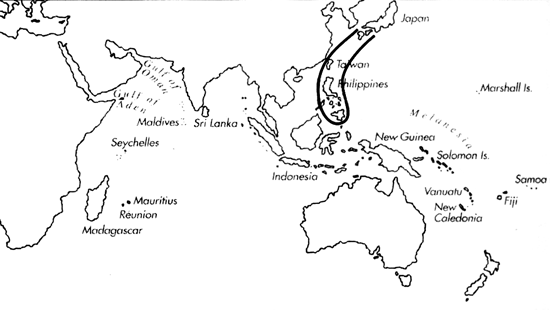Range: Japan to Philippines.
Description: Moderately small to medium-sized, moderately solid. Last whorl ventricosely conical to conical; outline slightly convex to straight, left side may be concave near base. Shoulder angulate to carinate, often weakly tuberculate or undulate. Spire of moderate height, outline straight to slightly sigmoid. Larval shell of about 3 whorls, maximum diameter 0.9- 1 mm. First 5-7 teleoconch whorls tuberculate. following whorls often carinate; tubercles may re-appear within the last 2 whorls. Teleoconch sutural ramps flat to concave, bearing dominant curved axial threads. Last whorl glossy, sculpture variable: smooth, with weak spiral ribs below centre, ribs occasionally granulose. sometimes heavily, from base to shoulder, especially toward outer lip in shells from Philippines.
| Shell Morphometry | ||
|---|---|---|
| L | 27-40 mm | |
| RW | 0.11-0.20 g/mm | |
| (L 27-37 mm) | ||
| RD | 0.59-0.64 | |
| PMD | 0.78-0.92 | |
| RSH | 0.12-0.20 | |
Ground colour white to pink. Last whorl variably encircled with orange-brown bands, often containing brown flecks and axial streaks. Overlying closely spaced spiral rows of brown dots extend from base to shoulder, but may be reduced or absent. Larval whorls white to grey. Postnuclear sutural ramps with brown radial blotches and brown dashes or dots oiouter margins. Aperture translucent.
Habitat and Habits: In Japan in 50- 150 m; Philippine shells in 240-300 m.
Discussion: C. otohimeae may resemble C. spirofilis and C. memiae; for the distinctions, see the Discussions of the latter species. Shells described as C. rogmartini from S. Philippines (Pl. 51, Figs. 15, 16) have granulose spiral ribs on last whorl.

C. otohimeae range map
This section contains verbatim reproductions of the accounts of 316 species of Conus from the Indo-Pacific region, from Manual of the Living Conidae, by Röckel, Korn and Kohn (1995). They are reproduced with the kind permission of the present publisher, Conchbooks.
All plates and figures referred to in the text are also in Röckel, Korn & Kohn, 1995. Manual of the Living Conidae Vol. 1: Indo-Pacific Region.
The range maps have been modified so that each species account has it own map, rather than one map that showed the ranges of several species in the original work. This was necessary because each species account is on a separate page on the website and not confined to the order of accounts in the book.